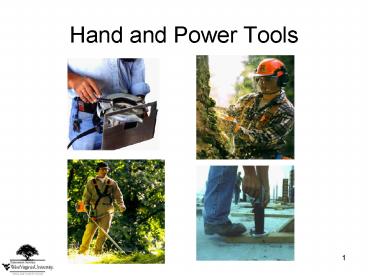Hand and Power Tools - PowerPoint PPT Presentation
1 / 16
Title:
Hand and Power Tools
Description:
Hand and Power Tools * This material was produced under grant number SH-22248-11-61-F-54 from the Occupational Safety and Health Administration, U.S. Department of Labor. – PowerPoint PPT presentation
Number of Views:812
Avg rating:3.0/5.0
Title: Hand and Power Tools
1
Hand and Power Tools
2
- This material was produced under grant number
SH-22248-11-61-F-54 from the Occupational Safety
and Health Administration, U.S. Department of
Labor. It does not necessarily reflect the views
or policies of the U.S. Department of Labor, nor
does mention of trade names, commercial products,
or organizations imply endorsement by the U.S.
Government.
3
Objectives
- After this module you should be able to
- identify the most common hand and power tool
hazards - take the necessary steps to avoid those hazards
4
Weed Trimmer Safety
- Keep your hands, face, and feet away from any
moving parts. - If the trimmer should become entangled, stop the
engine immediately. - Do not overreach. Always be properly balanced.
- Wear a full face shield, hearing protection, long
pants, and heavy work boots.
5
Leaf Blower Safety
- If your working area is dusty, wear a dust mask.
- Make sure the area is clear of other people where
you will be working. - Always wear proper clothing and eye/face and ear
protection while operating blowers.
6
Chain Saw Injury Locations
7
Before Starting Work
- Check controls, chain tension, bolts, and
handles. - Adjust according to manufacturers instructions.
- Fuel at least 10 ft. from ignition sources.
- Start at least 10 ft. away from fuel.
- Start with chain brake on and on the ground or
firmly supported.
8
While Working
- Keep hands on handles.
- Maintain secure footing.
- Clear area of things that get in the way.
- Do not cut overhead.
- Shut off or throttle released prior to moving.
- Shut off or chain brake engaged if terrain is
hazardous or going more than 50 ft. - Wear required PPE
9
Area of Kick-Back
- The top front of the bar is the area prone to
kick-back. - Always keep this in mind.
- No other part of the saw will work so hard to get
you!
10
Personal Protective Equipment
- A hard hat protects the head from falling limbs
or branches. - A mesh full-face shield prevents injury from
flying wood chips and twigs. - Protect ears from the high level of noise by
using earplugs. - Chainsaw safety boots and chaps, protect the feet
and legs in the event of accidental contact .
11
Leg Protection
- Each worker who operates a chain saw must wear
protection. - Made of cut resistant material.
- Extend from upper thigh down to boot top.
- Must be UL approved.
12
Operators Manual
- Keep the operators manual with the chain saw.
- If the manual is missing, contact the
manufacturer for a replacement. - Periodically review the manual for safe operating
procedures.
13
Check Your Knowledge
- What type of PPE should be worn when operating
weed trimmers ? - Eye protection
- Face protection.
- Hearing protection.
- All of the above.
14
Check Your Knowledge
- 2.What part of the body is most often injured by
the chainsaw itself? - Head.
- Upper body.
- Leg.
- Left hand.
15
Check Your Knowledge
- 3. Which part of the chainsaw bar is most prone
to kick-back? - The top front of the bar .
- The bottom front of the bar.
- The bottom of the bar.
- None of the above.
16
Additional Information
- http//www.cete.org/Trainer/ChainSawES.pdf
- http//www.osha.gov/OshDoc/data_Hurricane_Facts/ch
ain_saw_safety.pdf - http//www.osha.gov/OshDoc/data_Hurricane_Facts/ch
ainsaws.pdf - OSH Answers Chainsaws
- http//www.cete.org/Trainer/TrPruLadES.pdf
- http//www.cete.org/Trainer/TrPruTrmES.pdf
- http//www.osha.gov/OshDoc/data_Hurricane_Facts/tr
im.pdf - http//www.osha.gov/OshDoc/data_Hurricane_Facts/tr
ee_trimming_safety.pdf - http//landcarenetwork.org/planetFile/pdfs/PLANETS
afetyTips4feb06.pdf - http//www.cete.org/Trainer/SmallEngES.pdf































